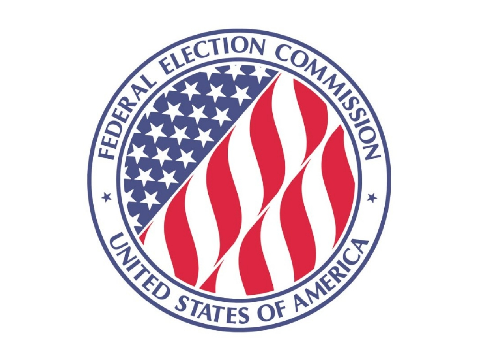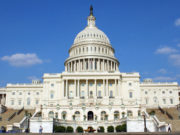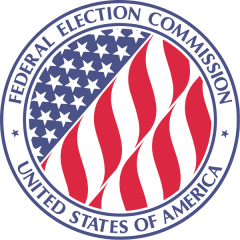Update: On November 28, FEC Chairman Allen Dickerson and Commissioner Shana Broussard submitted a revised draft of the proposed final rule. The revised draft, which was approved December 1 on a 5-0 vote (Commissioner Ellen Weintraub abstained), resolved the concerns noted in I through III below.
Regarding the small items exception we discuss below, after the vote the three Republican commissioners released statements indicating their views that the exception applies to certain internet ads. Chairman Allen Dickerson and Commissioner Trey Trainor released a statement that noted “in cases where even the adapted disclaimer provided by this regulation is too burdensome for a given advertising format, our existing regulatory exemptions for small items and impractical disclaimers will continue to apply.” Commissioner Sean Cooksey’s statement said that “Commission regulations will maintain exemptions from disclaimer requirements for small-item advertisements and communications for which disclaimers are impracticable, such as with exceptionally short video clips.”
Kudos to Allen Dickerson and Shana Broussard for leading the effort to finalize a sensible internet disclaimer rule and to Sean Cooksey, Commissioner Dara Lindenbaum and Trey Trainor for their efforts to refine and support it.
It’s great to see bipartisan efforts to improve the law.
If you’d like to learn more about the new rule, read a summary by Wiley partners Lee Goodman and Andrew Woodson.
I. Overview
While the latest Federal Election Commission “Draft Final Rule and Explanation and Justification for Internet Communications Disclaimers” is a big improvement over earlier FEC drafts, we believe it is not ready to become final.
First, key portions of the draft are unclear. If it’s not clear, then how will speakers who can’t afford lawyers be able to follow something they can’t understand? As former Justice Kennedy wrote in the Citizens United v. FEC[1] opinion, “[t]he First Amendment does not permit laws that force speakers to retain a campaign finance attorney … or seek declaratory rulings before discussing the most salient political issues of our day.”
Second, the draft rule would effectively ban certain ad formats that are available to commercial speakers. That strikes us as both poor policy and unconstitutional.
For these reasons, the draft rule would benefit from another round of public comment. Indeed, further comment may be required by the Administrative Procedure Act. There is adequate time for another round of comments and an improved final draft because the next primary elections are over a year away. The Commission should move promptly but also take the time to get it right. The potential costs to internet communications loom too large to make an unnecessary error.
II. Lack of Comment Under the Administrative Procedure Act
The Commission’s 2018 NPRM said, “The Commission has decided to reintroduce the proposed change to the definition of ‘public communication’ in this rulemaking for the limited purpose of determining whether the term ‘internet-enabled device or application’ is a sufficiently clear and technically accurate way to refer to the various media through which paid internet communications can be sent and received.” (emphasis added)[2] The actual changes in the draft final rule may go beyond that purpose, particularly by introducing the concept of “promoted.”
Under well-established principles of administrative law, a final rule need not be exactly the same as that on which the agency previously requested public comment. However, changes from the proposed rule must be a “logical outgrowth” of the proposed rule and request for comment. Here, where a prior notice emphasized that it was for a specific, “limited” purpose— “determining whether the term ‘internet-enabled device or application’ is [] sufficiently clear and technically accurate”—the introduction of the new provisions for “promoted” posts and communications would seem to go beyond that purpose and require a further comment period. Our remaining comments deal with two key areas in which added public comment would be valuable to get the rule right.
III. Vagueness Problems
Some terms in the draft rule are undefined and vague, and that would cause problems for those who seek to comply with it. This uncertainty may trigger numerous advisory opinion requests or, worse, complaints about speech not intentionally covered by the rule.
Of particular concern is the following proposed modification of 11 CFR § 100.26 (Public communications), which the draft would revise to state: “The term general public political advertising shall not include communications over the internet, except for communications placed or promoted for a fee on another person’s website, digital device, application, service, or advertising platform.” Similar language also appears in the new 11 CFR § 110.11(c)(5)(i).
We are particularly concerned about the undefined words “promoted” and “service.” Now, many people will probably think, “promoted means like a promoted tweet, where I’m paying Twitter to amplify this message.” But it’s not clear if that’s what the Commission thinks. On page 15 of the draft, for example, it refers to a comment using the term “‘promoted for a fee’ to capture individuals who are paid to share content in cases where no payment is made to the platform” on which the content appears. Does this mean the rule is incorporating that concept? We think that this was not the intent, but it’s not clear. On page 16, the draft says, the FEC “intends to regulate only communications placed or promoted for a fee ‘through an entity ordinarily owned or controlled by another person.’” But since a paid influencer would still be paid a “fee,” to make the communication “through an entity ordinarily owned or controlled by another person,” and given the history of overreach by regulatory advocates and, at times, the Commission, individual commissioners, and the Office of General Counsel, this should be clarified.
These and other terms, which are key to the proposed draft’s reach, are not clearly explained or further defined, and some are susceptible to being interpreted broadly. For example, is a social media influencer’s YouTube channel or video content an “advertising platform” if the influencer features paid promotions in his or her content? Such an interpretation would be plausible based on the plain rule text, but it seems to run contrary to the rule’s explanation that the rule is intended to only cover paid content that is distributed “through an entity ordinarily owned or controlled by another person.” To wit, a social media influencer’s YouTube channel or video content is not “an entity,” even though the channel and content are “controlled by” the influencer.
The rule also may, perhaps unintentionally, sweep in “communications … promoted for a fee on another person’s … service.” That’s awkwardly written and vague, but perhaps it includes a person providing services, such as speaking out online.
This also raises the question, what is a “service?” This may suggest that “promoted” includes paid spokespeople or campaign consultants, which may cause confusion. For example, would a campaign manager or communications director need to provide a disclaimer for every tweet, retweet, or liked tweet that encourages people to vote for their candidate? What about campaign consultants? Or is it meant to cover only internet-enabled services such as virtual reality services? We presume that it would not include campaign staff, but would prefer not to have to litigate such a matter, particularly in light of the recent practice of some commissioners refusing to close matters on which the Commission has voted against reason to believe, and then refusing to authorize the Office of General Counsel to defend the controlling commissioners’ decision in court.
That’s not the only question raised by these new vague definitions. Twitter is pondering a paid subscription option that may result in your tweets appearing in more feeds[3]. If that becomes available and people sign up for it, does that mean tweets by such subscribers could be deemed promoted public communications? Would the subscribers need to add a disclaimer if they tweet support for or against electing a candidate? If so, this might in turn force individuals to also list their phone numbers or home addresses if they don’t have a website. Some clarification, or a de minimis exemption, should address this problem.
The FEC received many serious and thoughtful comments throughout this process. But the draft ignores some of the best ones without any explanation or justification. Consider a portion of the Internet Association’s (IA) comment, to take just one example[4].
At the outset of the NPRM, the Commission has asked how to amend the definition of “public communication” to best capture internet communications as technology develops. The proposed language would amend the definition of public communication to state that “general public political advertising shall not include communications over the internet, except for communications placed for a fee on another person’s website or internet-enabled device or application.” The Commission asks whether this is a technically accurate way to describe how paid communications can and will be sent and received. IA believes this definition is generally appropriate and will remain relevant as technology advances, but that it could be modified slightly to be clearer. To that end, IA suggests the sentence be adjusted to say “general public political advertising shall not include communications over the internet, except for communications placed for a fee on a third-party’s website, application, platform, or internet-enabled device.” IA believes this more accurately captures the requirement for payment and a website, platform or device other than the speaker’s own.
IA was one of the few commenters with technical expertise responding to the 2018 NPRM question: “Is it clear from the proposed language that both the placement-for-a-fee requirement and the third-party requirement would apply to websites, internet-enabled devices, and internet applications?”
Yet the final draft rule, without adequate explanation or justification, selected the term “digital device” instead of “internet-enabled device,” selected “advertising platform” instead of “platform,” and added the word “service.”
IV. Lack of Small Items Exception and Ensuing Limitations on Effective, Low-Cost Ads.
The draft rule strongly implies that it would drop the small items and impracticable exceptions under 11 CFR 110.11(f)(1) for these paid ads. The draft says that “An internet public communication must include a disclaimer,” a video “disclaimer must be visible for at least 4 seconds,” and an audio disclaimer “must include a disclaimer that satisfies the requirements of paragraphs (b) and (c)(1) of this section.” It appears to provide no exception for video or audio communications that are either too short for the required disclaimers or commercially available display ads but where an adapted disclaimer is not possible. At the very least the explanation and justification should contain a straightforward statement explaining that the small items and impracticable exceptions apply in such circumstances, which will be relatively rare.
The language on page 31 is unclear. It says “[a]s discussed above, Commission regulations contain limited exceptions to the general disclaimer requirements, namely the small items and impracticable exceptions.” But it appears that statement is partial justification for the new CFR 110.11(g). Since the adapted disclaimer option appears after 110.11(f), that provides further evidence the small items exception may not apply.
Certain video or audio ads can’t contain the required disclaimers. Currently, a popular ad option on YouTube is the ”bumper ad,[5]” a non-skippable ad of six seconds or less. Some ads could be as short as two or three seconds. But since the draft rule requires a four-second disclaimer, the rule would effectively ban ads under four seconds.
Shorter messages can be highly effective. For example, a few years ago Under Armour created a new three-second ad[6] each time NBA star Stephen Curry made a three-point shot during the playoffs, proving that short messages can be both humorous and effective.
Many memorable presidential campaign slogans were less than two to three seconds. Here are some examples of these slogans:
-
-
- A chicken in every pot.
- Don’t swap horses in the middle of the stream.
- I like Ike.
- In your guts, you know he’s nuts.
- Are you better off than you were four years ago?
- It’s morning again in America.
- Where’s the beef?
- Yes we can.
- Change we can believe in,
- Make America Great Again!
- Build back better.
-
The obvious solution for video ads under four seconds long would be to allow shorter ads if the disclaimer appears for the duration of the ad. For example, the requirement could read instead:
If the disclaimer is displayed within a video, the disclaimer must be visible for the lesser of the time of the communication or at least 4 seconds and appear without the recipient of the communication taking any action.
A common Internet audio ad format on Pandora is 10 seconds[7], but Pandora recently offered ads as short as four seconds[8]. YouTube audio ads[9] can’t be over 15 seconds.
For audio ads, we suggest that the rule allow a PAC or other organization to drop all but the “paid for by” portion of the disclaimer if the ad is 15 seconds and omit the “paid for by” if it is obvious what organization sponsored the ad. This would let listeners know who sponsored the communication while permitting the organization to communicate its message.
Conclusion
The draft is a solid improvement over earlier versions. At the same time, portions of it are unclear and it may also inadvertently ban ad formats available to commercial advertisers. Allowing the public one more round of comments will likely improve the draft and ensure compliance with the Administrative Procedure Act. That in turn would lead to a clearer rule that will provide more options for speakers while conserving FEC resources by avoiding unnecessary complaints and advisory opinions that may be triggered by the current draft.
[1] 558 U.S. 310, 324 (2010).
[2] “Internet Communication Disclaimers and Definition of ‘Public Communication,’” 83 Fed. Reg 12864, 12865 (proposed May 26, 2018) https://www.federalregister.gov/documents/2018/03/26/2018-06010/internet-communication-disclaimers-and-definition-of-public-communication,
[3] Ashley Belanger, You get what you pay for; Mush floats several gimmicks to make Twitter profitable, ARS Technica, (November 11, 2022) https://arstechnica.com/tech-policy/2022/11/musk-floats-several-gimmicks-to-make-twitter-profitable/
[4] Letter from Michael Beckerman, CEO, Internet Association, to the Federal Election Commission (May 25, 2018) available at https://sers.fec.gov/fosers/showpdf.htm?docid=380576
[5] YouTube campaigns, Bumper ad campaigns, shorturl.at/jtMPT, (last visited November 14, 2022).
[6] Evan Schultz, Best of Curry 3 Second Ads, Best of Curry 3 Second Ads on Vimeo, (last visited November 14, 2022).
[7] SXM Media, Ad Specs, shorturl.at/hrNTV, (last visited November 14, 2022).
[8] Robin Kurzer, Pandora rolls out new Dynamic, Sequential and Short-form Audio ads, Martech (August 30, 2018). shorturl.at/hrSZ2 (last visited November 14, 2022).
[9] Google Ads, Create YouTube audio ads, shorturl.at/bMV12, (last visited November 14, 2022).














